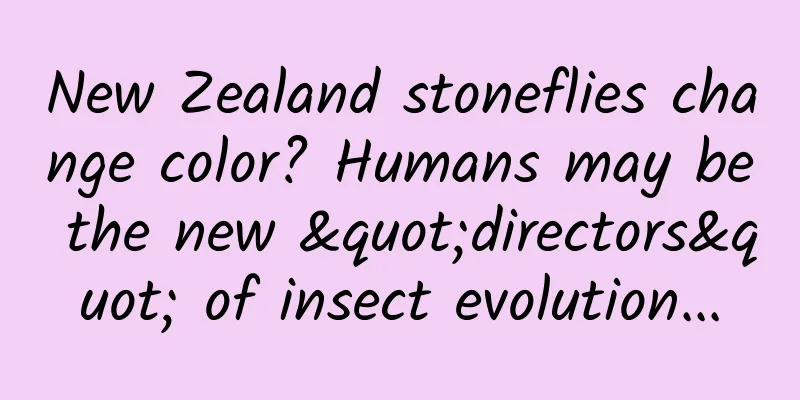New Zealand stoneflies change color? Humans may be the new "directors" of insect evolution...

|
Author: Yan Hui Duan Yuechu On the stage of nature, a silent yet significant evolutionary drama is taking place, and human activities have unknowingly become the "director" of this drama. Recently, a new study has attracted widespread attention from the scientific community. The study found that stoneflies native to New Zealand have changed their color, all in response to human-driven environmental changes. This result was published in the journal Science. The research from the University of Otago presents us with one of the world's clearest examples of animals evolving in response to human changes. In this case, Professor Jon Waters of the Department of Zoology pointed out that deforestation is an important reason for the color change of stoneflies. In natural forest areas, there used to be an interesting survival strategy. A local stonefly species evolved a "warning" color that mimics poisonous forest species. This "warning" color is like a "protective suit" given by nature, deceiving predators and making them mistakenly believe that these stoneflies are also poisonous, so they dare not attack easily. However, the arrival of humans broke this balance. As the forests were cut down, those poisonous species gradually disappeared. In areas where the forests disappeared, the mimics lost their objects of imitation, so they abandoned this once effective defense strategy and evolved into different colors. In fact, scientists have long explored the question of whether humans are causing evolutionary changes in natural populations. Before this, the most famous example of human-induced evolution was the peppered moth population in the UK. In the 19th century, industrial pollution was rampant and the color of the peppered moth changed. However, even this classic case is controversial. The study of stoneflies adds new and powerful evidence that human activities affect species evolution. From a broader perspective, human activities have many impacts on the natural environment, and these impacts are profoundly changing the relationships between organisms. As the example of stoneflies shows, humans have destroyed the ecological interactions between species that have evolved over millions of years. Forests, as complex ecosystems, are not only habitats for many species, but also a stage for interactions between species. When forests are cut down, the scenery of this stage is changed, and the relationships between the actors (various organisms) also change. Originally, on the big stage of the forest, a delicate balance was established between different species through various relationships such as predation, symbiosis, and mimicry. Poisonous species and the stoneflies that imitate them are part of this balance. But human logging is like roughly dismantling part of the stage, throwing the entire performance into chaos. However, it is gratifying that some of our native species have shown strong adaptability, Dr. Graham McCulloch pointed out. Like stoneflies, they are able to adjust their evolutionary direction in the face of rapid environmental changes caused by humans. This adaptability is a manifestation of the tenacity of life, and it also allows us to see the complexity and diversity of biological evolution under the influence of human activities. The significance of this study lies not only in the discovery of stoneflies' adaptation to environmental changes, but also in the fact that it reveals some universal laws in the evolutionary process. Independent stonefly populations in different regions have experienced similar changes in the face of deforestation. This shows that evolution can be a predictable process to a certain extent. From a global perspective, human activities have caused a variety of environmental changes, such as climate change, urbanization, and agricultural expansion. The impact of these changes on insects is not limited to changes in color. For example, climate change may cause changes in the temperature and humidity of insect habitats. Some insects that were originally adapted to temperate climates may migrate to high latitudes or high altitudes due to rising temperatures. During the migration process, they will encounter new species and new survival challenges, which may prompt them to evolve further. The process of urbanization has caused many insects to lose their natural habitats. They have to adapt to the artificial environment in the city, such as surviving in the cracks of buildings and feeding on food scraps discarded by humans. Even the reproduction cycle and behavior patterns of some insects may change as a result. Agricultural expansion is also an important factor. The large-scale use of pesticides not only directly affects the number of insects that survive, but may also lead to the gradual expansion of insect populations that are resistant to pesticides. The emergence of such resistance is an evolutionary manifestation of insects under the pressure of human activities. These insect populations that have adapted to the pesticide environment may change at the genetic level and pass on resistance genes to their offspring, thus forming unique insect population characteristics in agricultural areas. Let's go back to the example of stoneflies. It is like a microcosm that allows us to see the inextricable connection between human activities and biological evolution. We cannot ignore the impact of humans on the natural environment, and we should conduct in-depth research on the changes in organisms under these influences. Because this is not only related to the protection of biodiversity, but also to our understanding of the entire ecosystem and future management. We need to be more cautious in our behavior and think about how to reduce damage to nature as much as possible while developing, so as to reserve more space for the survival and evolution of organisms. Perhaps, in the future, by studying these evolutionary cases, we can find better ways to repair damaged ecosystems, so that those organisms affected by human activities can survive and reproduce better, and rebuild a harmonious natural world. In short, human activities have become an important factor affecting insect evolution. The color change of stoneflies is just the beginning, and more stories are constantly being played out on the vast stage of nature. As a powerful and influential role on this stage, we have the responsibility to pay attention to and protect every participant in this wonderful performance. References: Human actions likely cause insect color change | ScienceDaily |
>>: The longest-lived bubble on the ground! It can last for nearly half an hour without bursting
Recommend
"999 Cold Remedy" swept the screen, on the simple role of advertising in user operations
Recently, this advertisement of "999 Cold Re...
International Left-Handers Day | Are left-handed people really smarter?
August 13 is International Left-Handers Day, and ...
Case analysis: 4 key points of content platform operation!
The theme of this article is: 4 key points of con...
Space junk is increasing day by day. How should we deal with it? (Part 2)
In the book "The increasing amount of space ...
A ready-to-use product analysis framework
This is an original article about product analysi...
Do animals sleep well? They sleep standing up, hanging upside down, with their eyes open...
Sleeping is an indispensable behavior for us huma...
The latest and most comprehensive technology for Baidu Domination, Wanci Domination, and Douyin Domination
Introduction to the latest and most comprehensive...
Event promotion: A collection of 54 event cases for the 2019 Spring Festival!
During the Spring Festival, major Internet platfo...
Tencent OMG’s major adjustment: What exactly happened to the Internet content ecosystem?
Recently, Tencent OMG made major adjustments to i...
It is actually a close relative of spiders!
Nie Huang's "Illustrated Book of Sea Tal...
Zhihu VS Toutiao: What should you do if a big V is poached by someone with a high salary?
KOL stands for Key Opinion Leader. KOL operation ...
In 2020, new marketing innovation breakthrough!
First, I would like to talk about the two dimensi...
After the craze, all that is left for Bullet Messenger is a flash in the pan
[[242282]] "I don't remember where I hea...
How to create Douyin video accounts in batches, how to edit videos and movies, how to monetize them with products (with software)
The famous Lanshen Media is said to be not a trai...
How to choose promotion channels for efficient delivery?
Traffic is the essence of all business, whether o...









![6 Lessons for Effective HR Managers [Complete with Courseware]](/upload/images/67cc2bac7406c.webp)